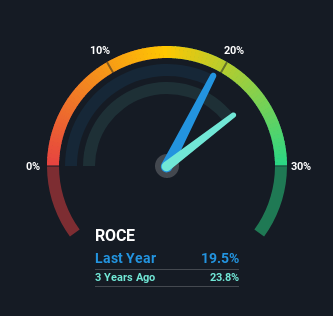Unilever (LON:ULVR) Has More To Do To Multiply In Value Going Forward
If we want to find a stock that could multiply over the long term, what are the underlying trends we should look for? One common approach is to try and find a company with returns on capital employed (ROCE) that are increasing, in conjunction with a growing amount of capital employed. If you see this, it typically means it's a company with a great business model and plenty of profitable reinvestment opportunities. With that in mind, the ROCE of Unilever (LON:ULVR) looks decent, right now, so lets see what the trend of returns can tell us.
Understanding Return On Capital Employed (ROCE)
For those that aren't sure what ROCE is, it measures the amount of pre-tax profits a company can generate from the capital employed in its business. To calculate this metric for Unilever, this is the formula:
Return on Capital Employed = Earnings Before Interest and Tax (EBIT) ÷ (Total Assets - Current Liabilities)
0.20 = €9.1b ÷ (€71b - €24b) (Based on the trailing twelve months to June 2021).
Thus, Unilever has an ROCE of 20%. On its own, that's a standard return, however it's much better than the 11% generated by the Personal Products industry.
See our latest analysis for Unilever
Above you can see how the current ROCE for Unilever compares to its prior returns on capital, but there's only so much you can tell from the past. If you're interested, you can view the analysts predictions in our free report on analyst forecasts for the company.
The Trend Of ROCE
The trend of ROCE doesn't stand out much, but returns on a whole are decent. The company has employed 42% more capital in the last five years, and the returns on that capital have remained stable at 20%. 20% is a pretty standard return, and it provides some comfort knowing that Unilever has consistently earned this amount. Stable returns in this ballpark can be unexciting, but if they can be maintained over the long run, they often provide nice rewards to shareholders.
What We Can Learn From Unilever's ROCE
In the end, Unilever has proven its ability to adequately reinvest capital at good rates of return. And the stock has followed suit returning a meaningful 41% to shareholders over the last five years. So while investors seem to be recognizing these promising trends, we still believe the stock deserves further research.
If you'd like to know about the risks facing Unilever, we've discovered 2 warning signs that you should be aware of.
For those who like to invest in solid companies, check out this free list of companies with solid balance sheets and high returns on equity.
Have feedback on this article? Concerned about the content? Get in touch with us directly. Alternatively, email editorial-team (at) simplywallst.com.
This article by Simply Wall St is general in nature. We provide commentary based on historical data and analyst forecasts only using an unbiased methodology and our articles are not intended to be financial advice. It does not constitute a recommendation to buy or sell any stock, and does not take account of your objectives, or your financial situation. We aim to bring you long-term focused analysis driven by fundamental data. Note that our analysis may not factor in the latest price-sensitive company announcements or qualitative material. Simply Wall St has no position in any stocks mentioned.

 Yahoo Finance
Yahoo Finance 
